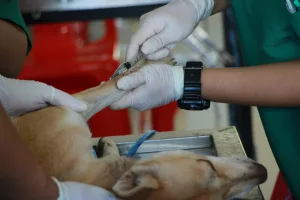Understanding your cat’s body language is crucial in deciphering their emotions and intentions. One common behavior that often leaves cat owners baffled is when their cat’s tail puffs up without an apparent reason. This sudden change in tail appearance can be alarming, but it serves as a vital communication tool for cats. The Science Behind Tail Puffing cats have an intricate communication system that involves various parts of their body, including their tail. When a cat’s tail puffs up, it is a clear indication of heightened arousal or agitation. This reaction is triggered by the cat’s autonomic nervous system, which controls involuntary responses to stress or excitement.
The Anatomy and Physiology of a Cat’s Tail
A cat’s tail is more than just a fluffy extension of their body. It’s an essential part of their anatomy, equipped with a complex structure of bones, muscles, nerves, and blood vessels. The tail is highly flexible, enabling a wide range of movement that assists in balance and communication.
- Bones and Muscles: A typical cat’s tail contains 19 to 23 vertebrae, connected by a series of muscles that allow it to move in various directions. This flexibility is crucial for expressing different emotions.
- Nerves and Sensitivity: The tail is sensitive to touch, thanks to numerous nerve endings. This sensitivity enhances a cat’s ability to react quickly to stimuli in their environment.
Possible Triggers for Tail Puffing
There are several reasons why a cat’s tail may puff up unexpectedly. Understanding these triggers can help you provide better care for your feline friend.
Fear or Anxiety
Cats are highly sensitive creatures. They may react to loud noises, sudden movements, or unfamiliar scents by puffing up their tail as a defensive mechanism. For instance, a cat might puff its tail when it hears fireworks or the vacuum cleaner. This behavior is akin to a human’s startle response—it’s automatic and often uncontrollable.
Practical Tips:
- Create a Safe Haven: Designate a quiet area in your home where your cat can retreat during stressful events. Fill this space with their favorite toys, blankets, and perhaps a piece of your clothing for comfort.
- Desensitize Gradually: If specific sounds or situations frequently trigger your cat’s anxiety, consider gradual desensitization. Play recordings of the sound at a low volume while offering treats, slowly increasing the volume over time.
Aggression and Territoriality
If a cat feels threatened or territorial, they may puff up their tail to appear larger and more intimidating. This behavior is often observed during conflicts with other animals or when a cat feels their territory is being invaded.
Real-Life Example:
Imagine two cats meeting for the first time. Both may exhibit tail puffing as a way to assert dominance or defend their space. This reaction might subside as they become more familiar with each other.
Practical Tips:
- Introduce Gradually: When introducing a new pet, allow the animals to sniff each other under a door before meeting face-to-face. Gradual introductions can prevent territorial disputes.
- Monitor Interactions: Keep a close eye on initial interactions and separate the animals if the tail puffing escalates into more aggressive behavior.
Health Concerns to Consider
While tail puffing is usually a behavioral response, it’s crucial to rule out any underlying health issues that may be causing the behavior. Pain or discomfort can lead to changes in a cat’s tail posture, including puffing up.
Recognizing Health Issues
If your cat’s tail puffing is accompanied by other concerning symptoms such as lethargy, loss of appetite, or aggression, it may be indicative of a health problem. Cats often hide their pain, so subtle changes in behavior should prompt a closer look.
Common Health Issues:
- Infections or Injuries: An infection or injury in the tail or spine can cause discomfort, leading to tail puffing. Look for signs like swelling or sensitivity to touch.
- Nervous System Disorders: Conditions affecting the nervous system can alter a cat’s typical responses to stimuli.
Practical Tips:
- Consult a Veterinarian: If you notice persistent puffing along with other symptoms, it’s wise to consult a vet. A thorough examination can rule out or diagnose underlying health issues.
- Observe Behavior Changes: Keep a diary of any changes in behavior or physical symptoms to share with your vet. Detailed notes can help in diagnosing the issue.
Managing Tail Puffing Behavior
If your cat’s tail puffing is becoming a frequent occurrence, addressing the underlying cause is essential. Providing a safe and stress-free environment for your cat, enriching their living space with toys and scratching posts, and ensuring regular play and exercise can help reduce anxiety and prevent tail puffing episodes.
Environmental Enrichment
Cats thrive in environments that stimulate their natural instincts. Proper enrichment can prevent stress-related behaviors like tail puffing.
Ways to Enrich Your Cat’s Environment:
- Interactive Toys: Toys that mimic prey, like feather wands or battery-operated mice, can provide mental and physical stimulation.
- Vertical Spaces: Cats love to climb and observe from high places. Install shelves or cat trees to give them vantage points for surveying their territory.
- Scratching Posts: Having multiple scratching posts throughout the house can help reduce stress and provide an outlet for natural clawing behavior.
Understanding Body Language
Observing your cat’s body language and learning to recognize their stress signals can help you intervene before the situation escalates. A puffed-up tail is just one part of a larger picture.
Other Body Language Cues:
- Ears: Ears flattened against the head indicate fear or aggression, while forward-facing ears suggest curiosity.
- Eyes: Dilated pupils can be a sign of excitement or fear, while slow blinking indicates relaxation and trust.
Practical Tips:
- Respond Appropriately: If your cat is showing signs of stress, remove them from the situation if possible. Use a calm voice to reassure them.
- Positive Reinforcement: Reward calm behavior with treats or affection, reinforcing the idea that relaxation leads to positive outcomes.
Building a Stronger Bond with Your Cat
Understanding why your cat’s tail puffs up without an apparent reason requires a careful analysis of their environment, behavior, and overall health. By observing and interpreting your cat’s body language, you can gain valuable insights into their emotional state and provide the necessary support to ensure their well-being.
Strengthening the Human-Cat Relationship
A strong bond between you and your cat can alleviate stress and reduce behaviors like tail puffing. Trust-building takes time and patience.
Steps to Build Trust:
- Consistent Routine: Cats find comfort in routine. Feed and play with your cat at the same times each day to create a predictable environment.
- Respect Personal Space: Allow your cat to approach you on their terms. Forcing interaction can increase anxiety.
- Quality Time: Spend time with your cat doing activities they enjoy, whether it’s cuddling, playing, or simply being in the same room.
Common Mistakes and How to Avoid Them
Owners can sometimes inadvertently worsen tail puffing by reacting incorrectly.
Mistakes to Avoid:
- Punishment: Never punish your cat for puffing their tail. This behavior is a natural response to a stimulus and punishing them can lead to fear or aggression.
- Ignoring Signs: Failing to recognize the signs of stress or discomfort can exacerbate the issue. Always be attentive to changes in behavior.
Practical Tips:
- Educate Yourself: Learn about feline behavior and body language to better understand your cat’s needs.
- Seek Professional Help: If tail puffing becomes a significant issue, consider consulting a pet behaviorist for additional strategies.
By paying attention to these subtle cues, you can strengthen your bond with your feline companion. Tail puffing is just one of the many ways cats communicate, and by understanding this behavior, you can ensure a happier, healthier life for your furry friend.



